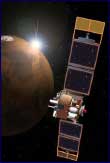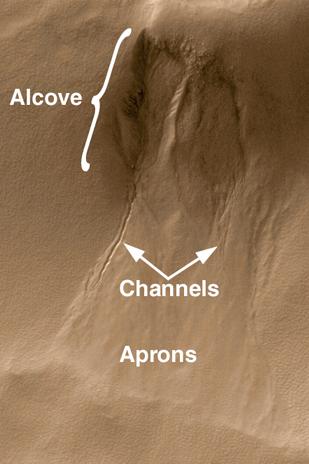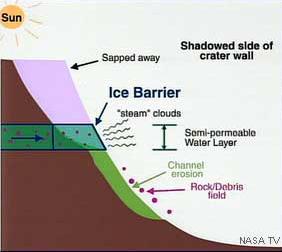
Where is the Water on Mars now?
Mars Global Surveyor (MGS)
Launched in November, 1996, MGS began mapping Mars in April, 1999 at an
altitude of 250 miles. Perhaps one of the most significant findings
was evidence of water flowing relatively recently.
 Gullies seen on Martian cliffs and crater walls in a small number of
high-resolution images suggest that liquid water has seeped onto the surface in the
geologically recent past.
Gullies seen on Martian cliffs and crater walls in a small number of
high-resolution images suggest that liquid water has seeped onto the surface in the
geologically recent past.

The relative freshness of these features
indicate some of them are active today--liquid water
may presently exist at depths of less than 500 meters (1640
feet) beneath the Mars surface.
These results from the MGS have two profound implications:
1) If water
is this accessible, it makes colonization of Mars
more feasible.
2) We should be searching much DEEPER in the Martian ground for life.
Results from the Rovers
The Mars rovers, Spirit and Opportunity, landed in January 2004 on an
$835 million mission to search for signs of past water on the planet.
They have uncovered tantalizing evidence of a watery past on the Red Planet,
though the data are still being sifted.
Could life have ever formed on Mars?
In Earth's history, the important time for the formation of life is between 3.5 and 3.8 b.y.a.
Mars may have had very similar conditions at this time. We know rocks can be exchanged
from one planet or moon to another. Might bacteria-ridden rocks from Earth, hurled into
space from large meteorite impacts, make their way to the Martian surface? It would take
millions of years, but maybe some bacteria could survive the trip.